Physical Address
304 North Cardinal St.
Dorchester Center, MA 02124
This is also known as a neural tube defect (NTD), and are a group of congenital spine abnormalities that may cause progressive neurological damage (affecting 1 : 1000 live births)
The common feature is an anomaly of the midline structures of the back
It results from incomplete midline closure of the bony and neural spinal tissues following defective primary neural tube closure and persistence of the neural placode ▸ it is also associated with anomalous development of the caudal cell mass
Neural placode: a flat segment of un-neurulated nervous tissue
It can occur in closed (spina bifida occulta) and open (spina bifida aperta) forms
Spina bifida occulta: this is due to a failure of fusion of the posterior spinal bony elements ▸ the defect is covered by skin
Without a tethered cord: this is commonest at L5 or S1 ▸ it occurs in approximately 20% of the general population with no neurological problems (± back pain)
With a tethered cord: neurologic defects are uncommon ▸ a cutaneous lesion such as a dimple, sinus, hairy naevus or haemangioma may be a marker of an underlying defect and is seen in 50% of cases
Associations: meningocele ▸ lipomyelomeningodysplasia ▸ diastematomyelia ▸ neurenteric cyst ▸ dermoid and epidermoid cysts ▸ dorsal dermal sinus ▸ caudal agenesis ▸ myelocystocele ▸ spinal or filum terminale lipoma
Spina bifida aperta : the nervous tissue is exposed and neurologic defects are common
Most are myelomeningoceles and are virtually always associated with a Chiari II malformation ▸ they are usually found within the lumbosacral region
Usually the neural placode protrudes beyond the skin level with an expanded CSF containing sac lined by meninges ▸ occasionally it is a myelocele where the placode is flush with the surface and no meningocele component is present
Nerve roots (from the everted ventral placode) cross the widely dilated meningocele subarachnoid spaces to enter the neural exit foraminae ▸ the posterior elements of the vertebral column and the other mesenchymal derivatives (e.g. paravertebral muscles) remain everted
It is surgically repaired soon after birth, as untreated and exposed neural tissue is prone to ulceration and infection
Herniation of the spinal meninges through the intervertebral foramina or a vertebral body defect ▸ varying degrees of dural ectasia usually accompany spinal dysraphisms
Generalized or focal dural ectasia may also be seen in: neurofibromatosis ▸ Ehlers–Danlos and Marfan's syndromes ▸ erosive arthropathies (e.g. ankylosing spondylitis)
Types of meningocele
Anterior thoracic meningocele with ventral herniation of the spinal cord : this is most easily recognized with a midsagittal MRI of the thoracic spine where the spinal cord is displaced anteriorly and is in contact with a vertebral body near an intervertebral disc (commonly T6)
Lateral thoracic meningocele: this commonly presents as a paravertebral mass (CXR) ▸ it is usually solitary and located on the right ▸ there is an angular kyphoscoliosis towards the side of the meningocele with pressure erosion of the relevant intervertebral foraminal margins
Neurofibromatosis is present in up to 85% of cases
Posterior meningocele: herniation of the CSF sac (which is lined by dura and arachnoid) through a spinal defect results in a clinically apparent mass covered by skin ▸ it occurs mainly within the lumbosacral region
Anterior sacral meningocele: these are typically presacral and appear as a unilocular, complex lobular or multilocular cystic mass (the mass contains CSF which communicates with the intraspinal subarachnoid space) ▸ there is usually a large eccentric anterior lower sacral defect (with a pathognomonic scimitar appearance on XR) and an expanded sacral canal ▸ there can be varying degrees of sacral or coccygeal agenesis
It presents in older children and adults with low-back pain and bladder or bowel disturbance
Terminal myelocystocele : the central canal is dilated by a large hydromyelic cavity herniating into a posterior meningocele (through a posterior spinal bony defect) ▸ it is rare, and associated with syndromes such as VACTERL
Myelomeningocele: herniation of the spinal meninges and spinal neural tissue through a vertebral canal defect
Myelocele: the neural placode is flush with the skin surface but there is no skin covering
Hemimyelomeningoceles and hemimyeloceles may occur with diastematomyelia
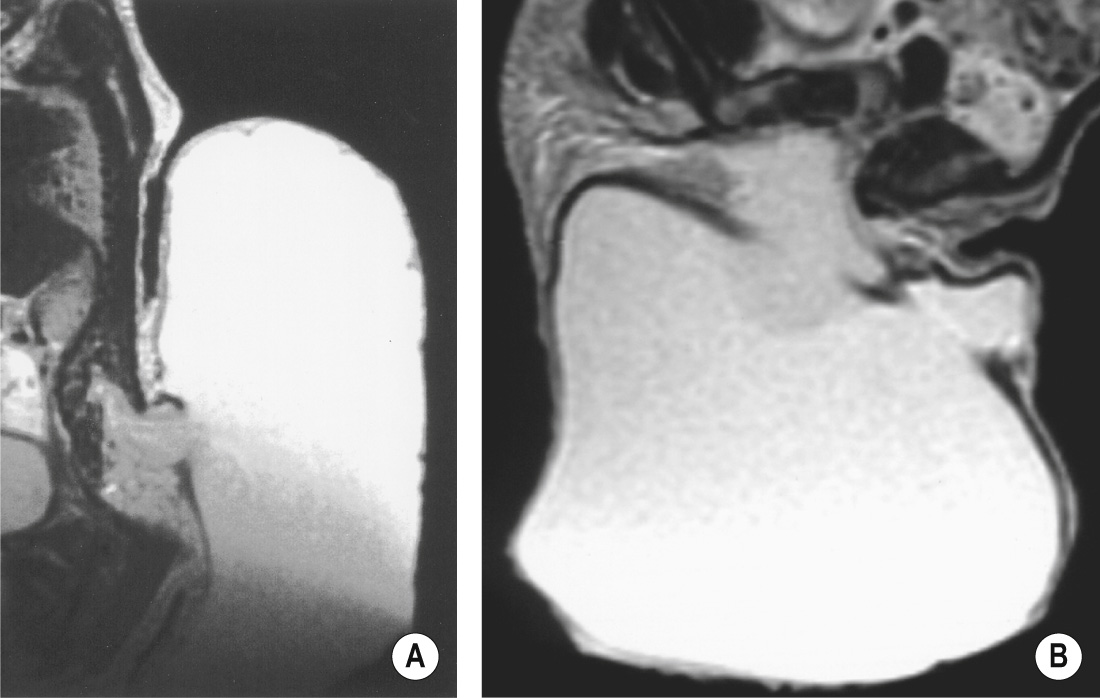
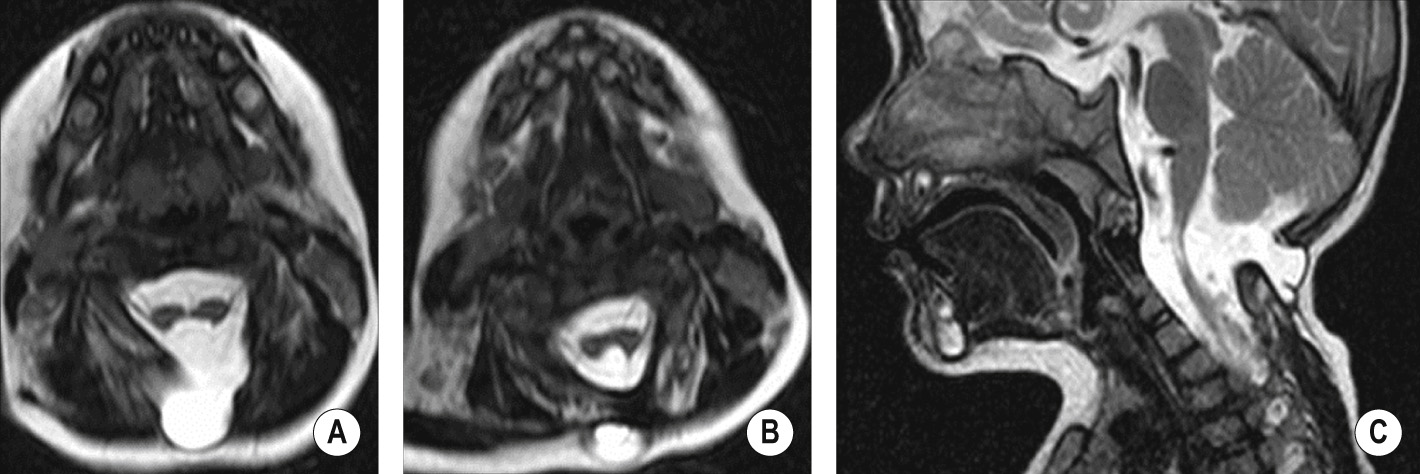
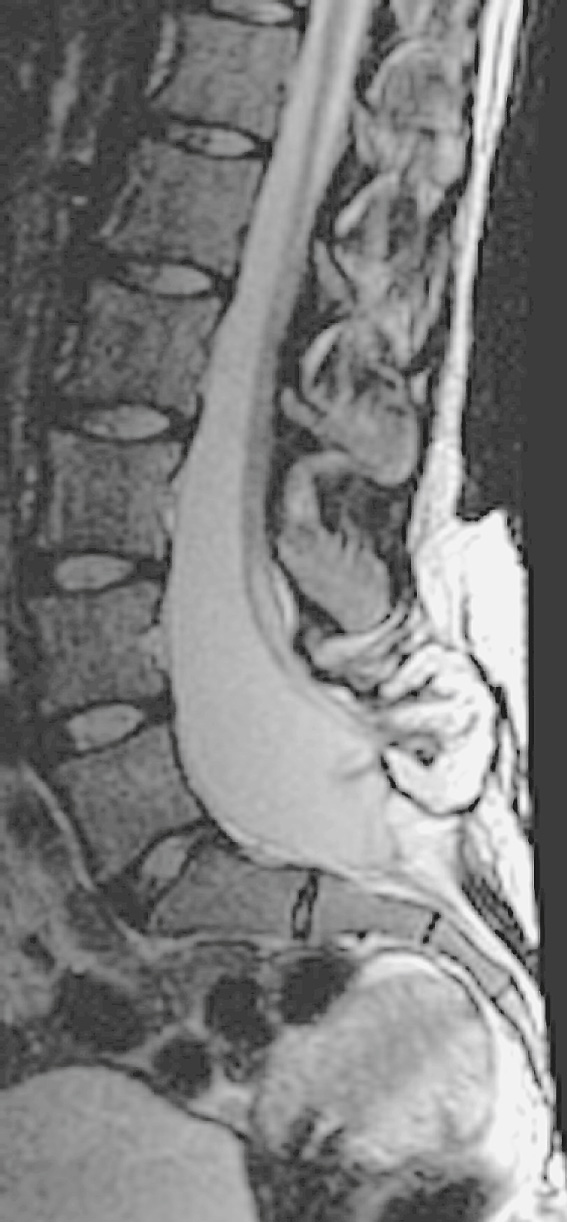
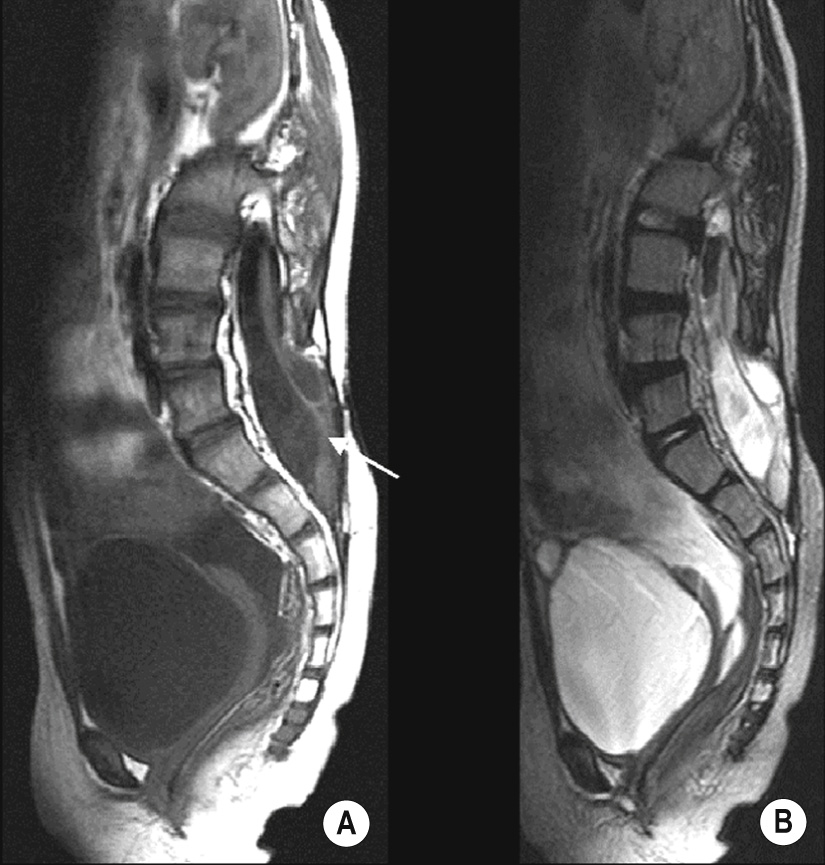
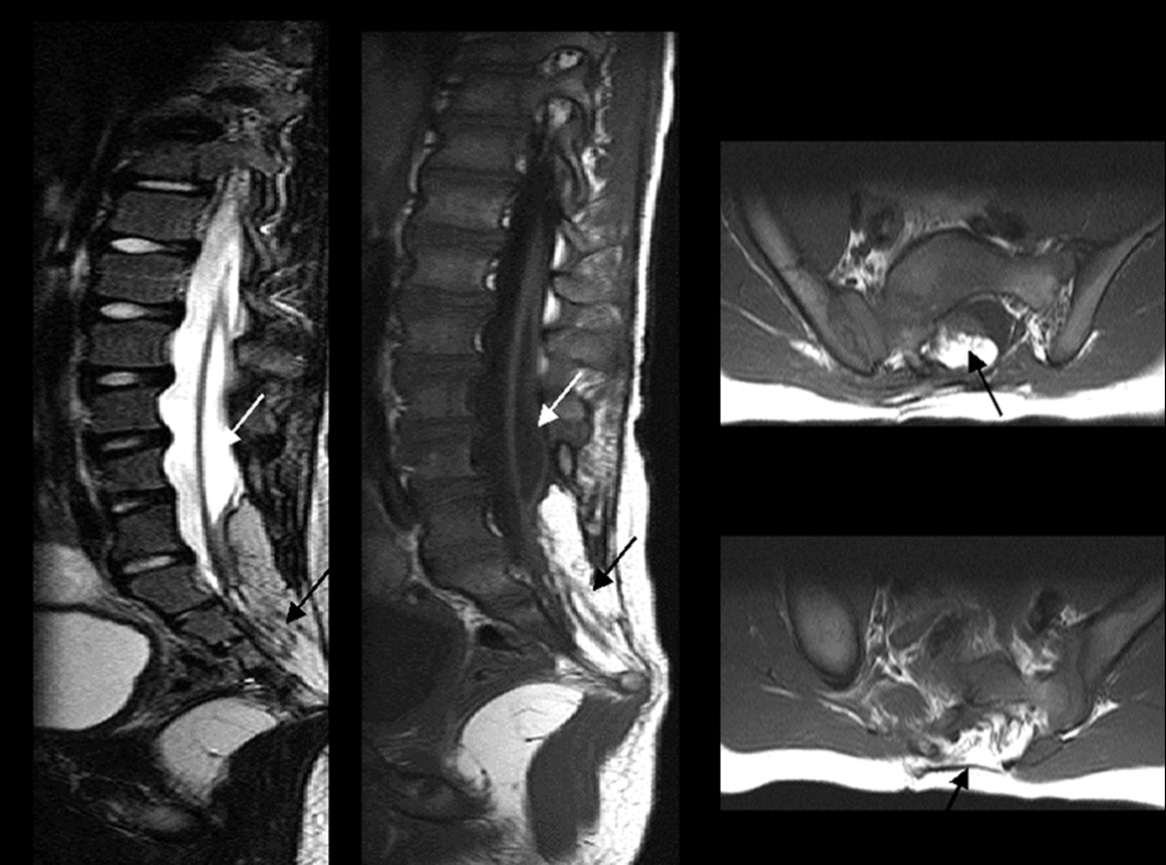
A low-lying conus medullaris tethered by a short thick filum terminale ▸ it is commonly a component of other spinal malformations (e.g. a spinal lipoma)
The spinal cord reaches the adult position by term – the majority lie between T11/12 and L1/2 (it is abnormal if it is seen at or below the level of L3)
Progressive neurological deterioration due to traction damage on the tethered cord
A low-lying conus ▸ an enlarged thecal sac ▸ a thickened (>1.5 mm) filum terminale
It may be associated with a spinal cord syrinx
Intramedullary/intradural lipomas: a mass of adipose tissue located mainly between the posterior spinal cord columns (a tongue-like extension along the central canal can often be seen) ▸ the overlying dura mater is usually intact and the lipoma entirely intradural – however, there may be a dural defect to which the cord and lipoma become adherent
Its usual location is near the thoracocervical or craniovertebral junctions
CT and MR will demonstrate the fatty nature of the tumour
Filum terminale lipoma: an asymptomatic fatty thickening of the filum terminale as a result of a disturbance of caudal regression ▸ it is considered a normal variant in the absence of a clinical tethered cord syndrome (and is seen in up to 5% of the normal population)
These represent a spectrum of abnormalities ranging from an abnormally low conus medullaris (with minimal or even absent lipoma) to massive lipomatous formations involving all elements of the spinal and adjacent subcutaneous tissues
Lipomyelocele: a lumbosacral neural lipomatous lesion continuous with the subcutaneous fat via a dysraphic spinal defect (tethering the spinal cord)
Lipomyelomeningocele: a lipomyelocele + a meningocele
These frequently present in adult life (sometimes with only back pain or minimal neurological signs)
There is non-fusion of ≥1 neural arches (± variable spinal canal expansion)
T1WI/T2WI: a high SI lipoma continuous with the subcutaneous fat (± spinal canal extension) ▸ the spinal cord terminates at or below the level of L3 (in 80% of cases), and is usually tethered to the dorsal dura where it fuses with the lipoma ▸ nerve roots issuing from an apparently thickened filum terminale indicate it contains significant nervous tissue and should not be surgically divided
This results from incomplete separation of the notochord from the endoderm, or from herniation of the endoderm into the dorsal ectoderm ▸ the cyst attachment to the notochord can prevent vertebral body fusion (leading to spinal anomalies)
It forms part of the ‘split notochord’ syndrome : this is a persistent connection between the endoderm and ectoderm resulting in splitting or deviation of the notochord:
Dorsal enteric fistula: the most severe form, representing a fistula connecting the intestinal cavity with the midline dorsal skin surface (therefore travelling through soft tissues and spine)
Dorsal enteric (dermal) sinus: this is a remnant of the posterior portion of the fistula with a blind ending tube opening onto the skin surface
Dorsal enteric cyst (neurenteric cyst): this is a trapped remnant of the middle portion of the fistula and is found within the intraspinal or paraspinal compartments
Dorsal enteric diverticulum: this is a remnant of the anterior portion of the fistula with a tubular diverticulum originating from the dorsal bowel mesentery
Intraspinal neurenteric cysts : intradural (usually unilocular) cysts are lined by gastrointestinal or bronchial epithelium and are usually anterior to the spinal cord ▸ they occur within the cervical or lower thoracic regions and can compress the spinal cord (usually the anterior aspect)
A focal expansion of the spinal canal (butterfly or hemivertebrae are associated with thoracic lesions)
T1WI / T2WI: the cyst contents are usually of high SI (relative to CSF)
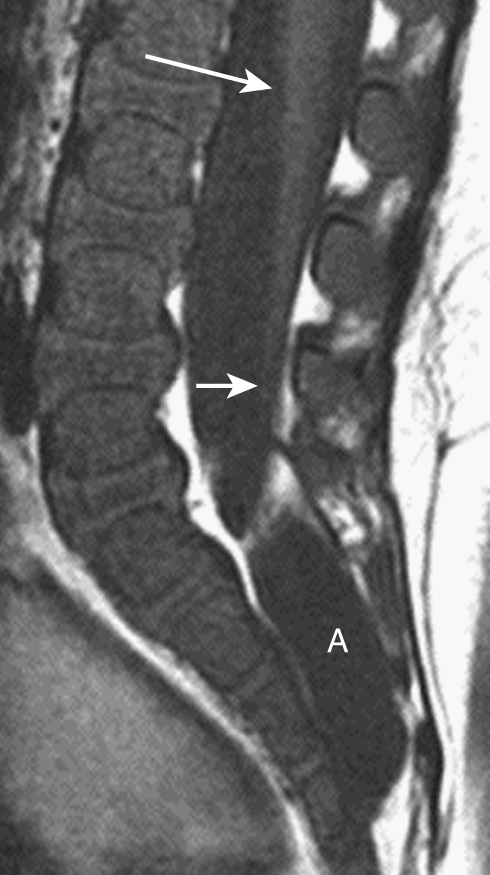
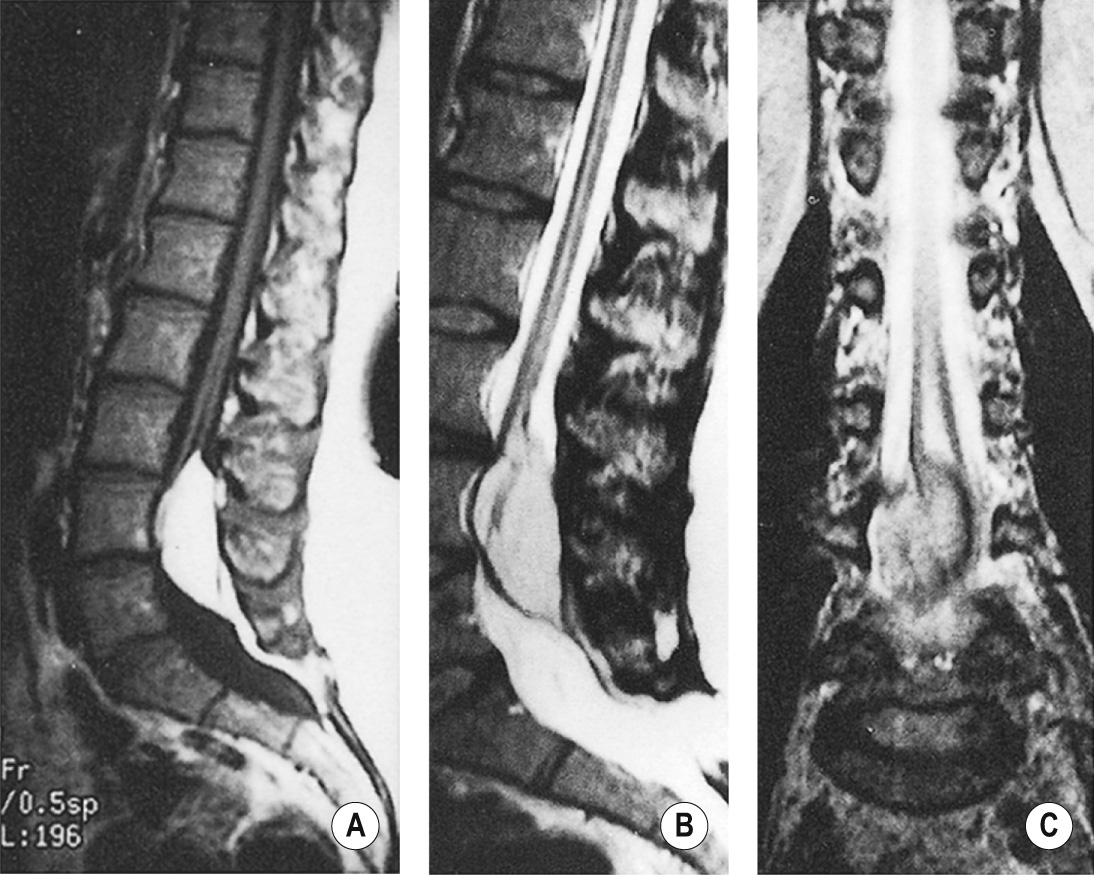
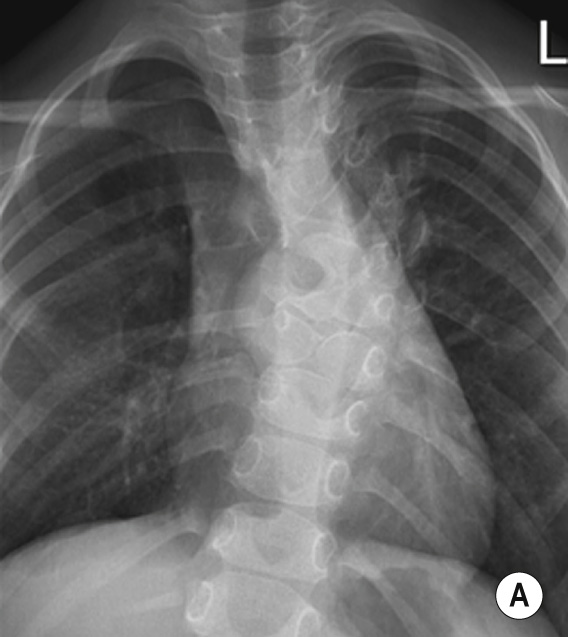
This forms part of the ‘split notochord’ syndrome: the spinal cord is split into two (usually unequal) hemicords ▸ each hemicord has a central canal and an anterior spinal artery but only gives off the ipsilateral spinal roots from one anterior and one posterior grey matter horn ▸ the hemicords nearly always re-unite caudally
They are usually found within the thoracic cord, extending over several vertebral segments
A focal expansion of the spinal canal with narrowed intervertebral disc spaces ▸ there are varying degrees of laminar dysplasia and fusion
The hemicords are enclosed within a common dural tube in 50% of cases but in the remainder each is enclosed within its own dural tube ▸ they are usually located within the cervical region ▸ a bony or cartilaginous midline extradural spur may arise from the malformed lamina which often lies between each hemicord
Vertebral segmentation abnormalities are usually present (e.g. a hemivertebrae or bifid/fused vertebrae)
Syringohydromyelia (50% of cases) ▸ a tethered cord (75% of cases)
A benign tumour arising from cells that can produce skin and its appendages ▸ it can be congenital or acquired (e.g. following a lumbar puncture)
It is commonly located within the lumbosacral or cauda equina regions
A rounded intradural (occasionally intramedullary) lesion demonstrating fat (± calcification) ▸ in 20% a dorsal dermal sinus can be traced to a skin dimple on the lower back (this is a possible source of intradural sepsis)
An epithelial-lined skin opening with a variable fistulous extension to the dural surface ▸ it typically affects the lumbosacral region ▸ it is often associated with cutaneous stigmata (e.g. a hairy naevus or capillary haemangioma)
A thin linear strip of tissue hypointense to the adjacent fat
Dermal openings at the sacrococcygeal level: these are directed inferiorly below the thecal sac (sacrococcygeal pits) ▸ they do not require further imaging
Dermal openings above the intergluteal cleft: these pass superiorly and may form a fistulous connection with the dural sac ▸ these warrant further investigation
This follows the abnormal development of the caudal cell mass as a result of apoptosis of notochordal cells which have not formed at the correct craniocaudal position
Caudal agenesis: absence of the vertebral column at the affected level (as well as a truncated spinal cord, an imperforate anus and genital anomalies)
Type I: there is a high (often T12) abrupt spinal cord termination ▸ there is a characteristic wedge-shaped configuration with variable coccygeal to lower thoracic vertebral aplasia
Type II: the true notochord is not affected and only the caudal cell mass is involved ▸ the vertebral aplasia is less extensive (with up to S4 present as the last vertebra)
Associations:
OEIS: o mphalocele/ e xstrophy/ i mperforate anus/ s pinal defects
VACTERL: v ertebral anomalies/ a nal atresia/ c ardiovascular anomalies/ t racheoesophageal fistula/ o esophageal atresia/ r enal or r adial abnormalities/ l imb anomalies
Currarino triad: Partial sacral agenesis + an anorectal malformation + a presacral mass (either a teratoma or anterior meningocele)
Segmental spinal dysgenesis: a rare segmental abnormality affecting the spinal cord, segmental nerve roots and vertebrae
Associations: congenital paraparesis ▸ lower limb deformities
An acute angle kyphus ▸ the spine and spinal cord may appear severed (the most severe cases) or focally hypoplastic (less severe cases)
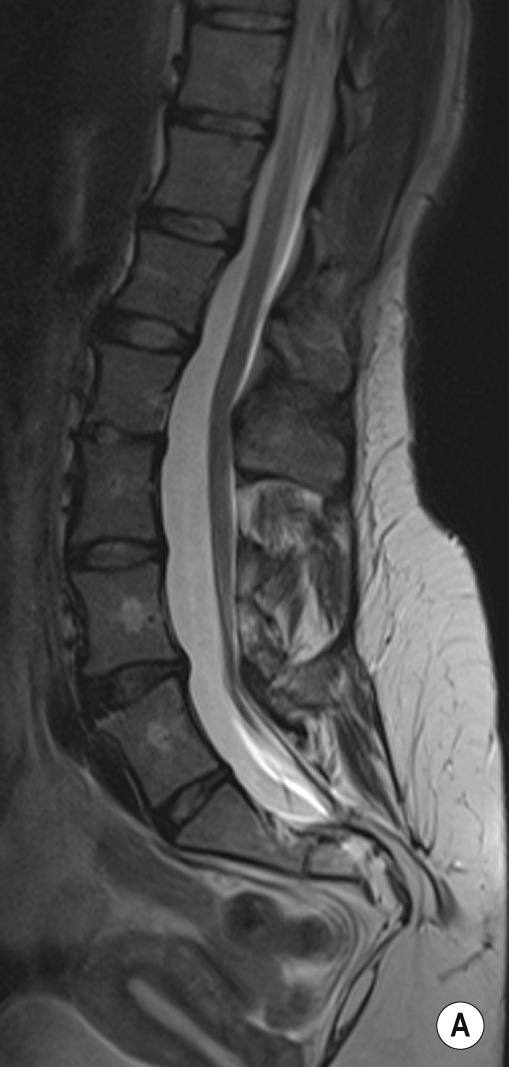
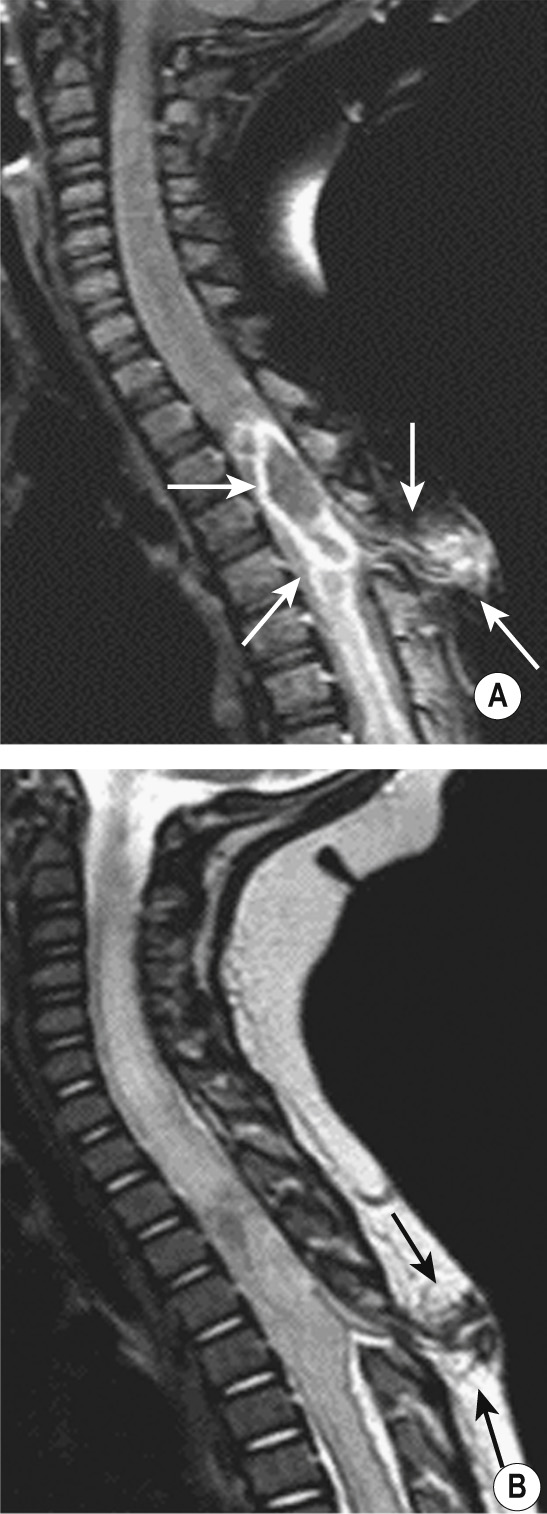
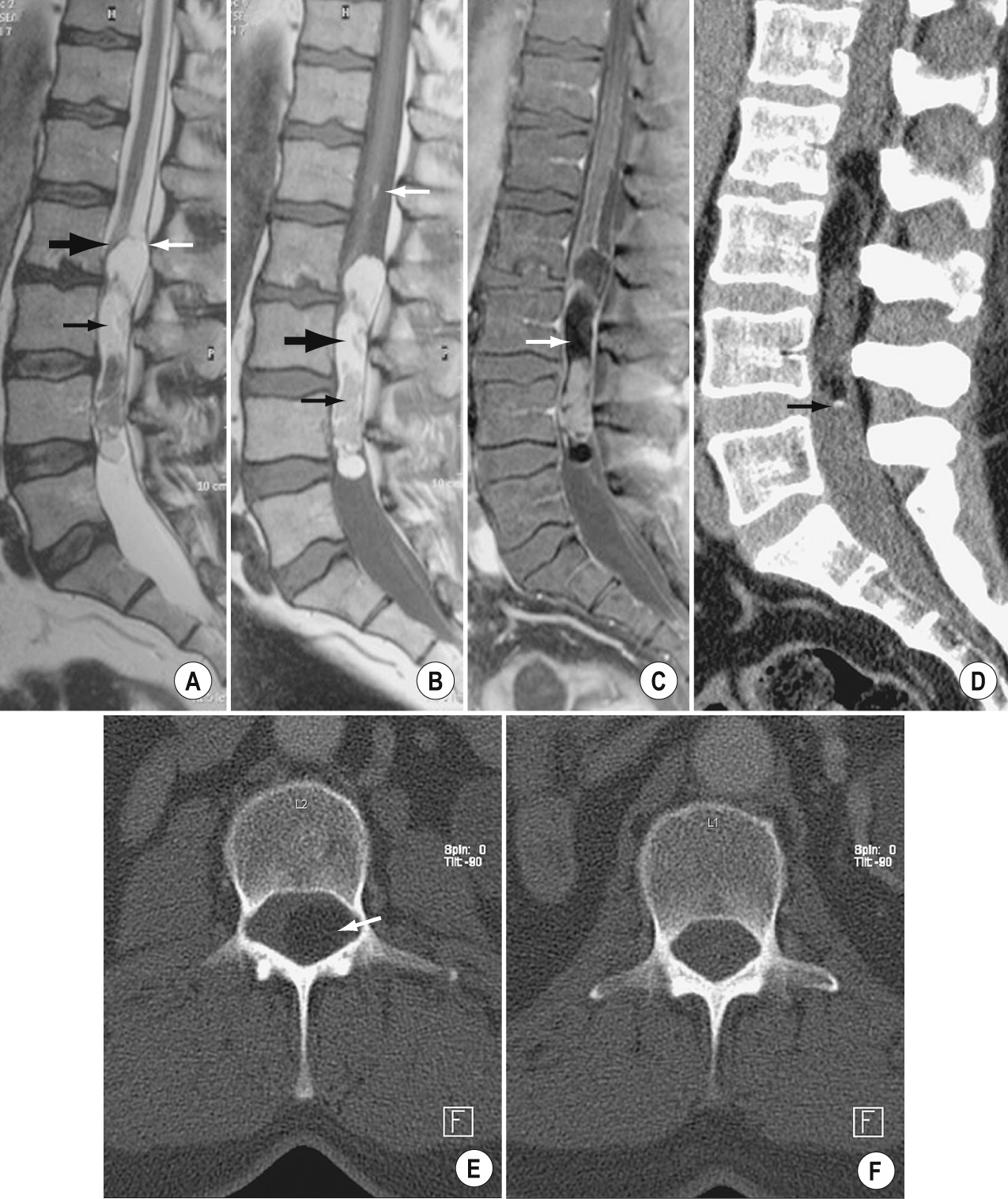
A longitudinal CSF filled cavity that is lined mainly by glial tissue ▸ it usually involves many segments (or the whole cord) ▸ it follows either cord damage (and subsequent cavitation) or CSF that has been abnormally driven into the cord (via the perivascular spaces) ▸ as a result of hydrodynamic forces the lesion is capable of propagating into normal cord tissue
Syringomyelia: the cystic cavity is not continuous with the central cord canal
Hydromyelia: cystic dilatation of the central cord canal
Syringohydromyelia: features common to both of the above
It is commonly located within the cervical cord (only 10% extend cranial to C2)
Cerebellar ectopia (70–90%) with the cerebellar tonsils usually lying at the level of C1 or C2
An expanded spinal canal (30–40%) ▸ scoliosis
An enlarged spinal cord (affecting 80% of cases) which varies with changes in posture or respiration ▸ a well circumscribed CSF cavity often demonstrating prominent transverse ridges within its wall (giving a beaded or loculated appearance) ▸ pulsatile cysts can show flow-related signal changes
A loculated CSF fluid collection:
Extradural: these arise from defects within the dura mater (congenital or inflammatory)
Intradural: these arise from arachnoidal duplications or spinal arachnoiditis
Tarlov cyst: a perineural arachnoid cyst occurring commonly within the sacrum (especially on the 2 nd sacral root) ▸ can be large ▸ it is of doubtful clinical significance
Pain or neurological disability if the spinal cord or cauda equina is compressed ▸ aspiration of cysts compressing the cord can improve symptoms
Spinal canal expansion (with extradural cysts)
A well-defined cystic structure that often demonstrates higher SI than CSF (due to its reduced mobility) ▸ they can be multiple and are rarely associated with myelomalacia or syringomyelia ▸ extradural lesions can be overdiagnosed within the thoracic region (the thoracic spine is commonly wide and partly loculated)
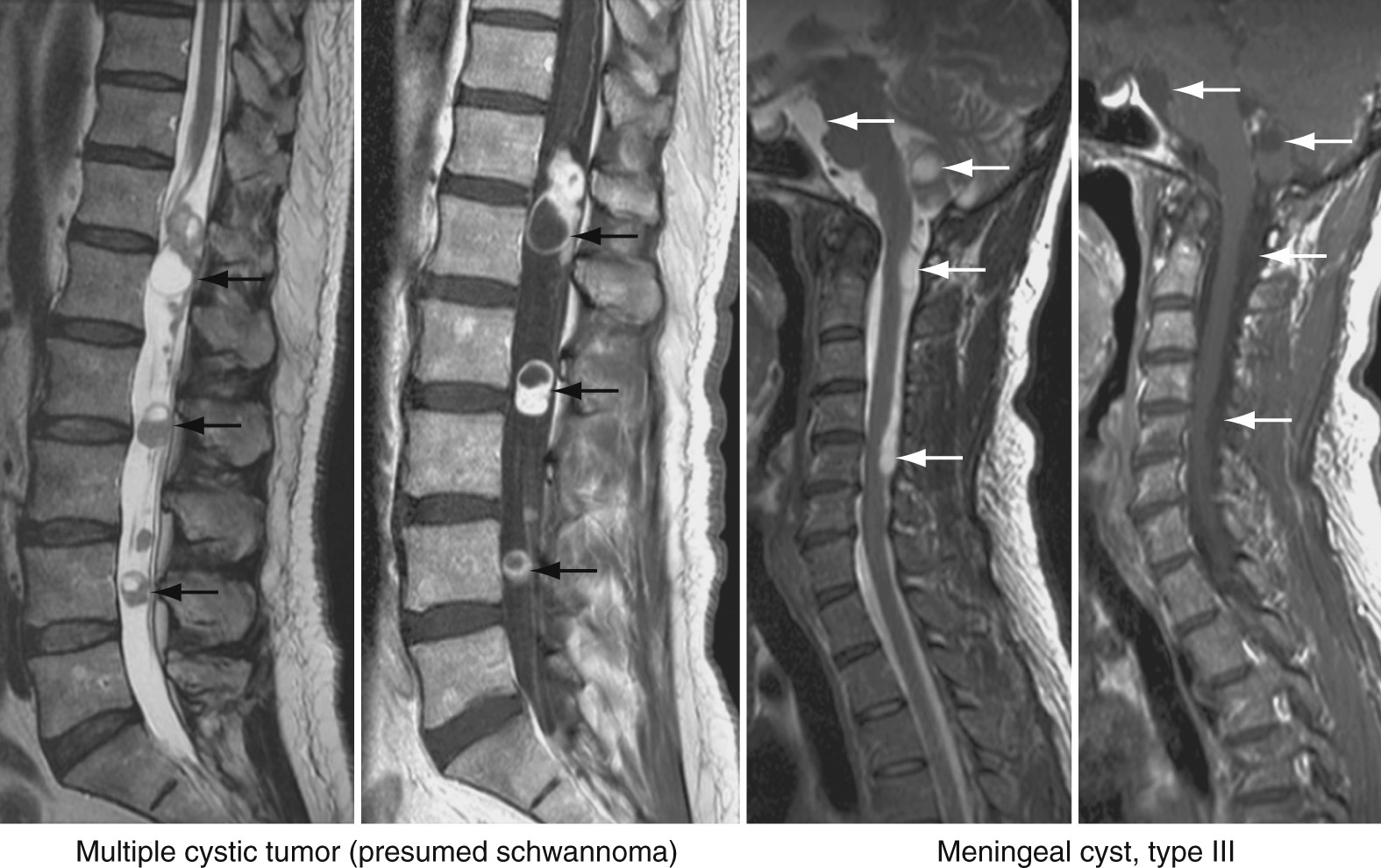
An autosomal dominant dwarfism affecting the spine and extremities
A decreasing lumbar spine interpedicular distance in the caudal direction ▸ bullet-shaped vertebral bodies ▸ short pedicles ▸ posterior vertebral body scalloping ▸ lumbar hyperlordosis ▸ a ‘champagne glass’ pelvis ▸ squared pelvic iliac wings
Inherited lysosomal storage disorders
Instability and subluxation at the atlantoaxial joint and thoracolumbar junction (due to ligamentous laxity) ▸ upper spinal cord compression (due to ligamentous thickening) ▸ dens hypoplasia ▸ posterior vertebral body scalloping
Central vertebral beaking
Especially marked thickening of dural and extradural tissues ▸ dens hypoplasia ▸ posterior vertebral body scalloping
Inferior vertebral beaking
Flattened or enlarged vertebrae in an AP dimension (especially with a thoracic kyphosis) ▸ there may be a severe scoliosis
Neurological complications are uncommon
Neurofibromatosis type I is usually associated with a skeletal dysplasia:
Severe scoliosis (50%) ▸ dysplastic vertebrae (10%) – often consisting of ≥1 absent or hypoplastic pedicles ▸ dural ectasia (10%) ▸ C1/2 or C2/3 subluxation or spinal compression (16%)
Narrowed intervertebral discs which are partly bridged by regions where the disc material never formed early in development
The fused segments usually show varying degrees of hypoplasia ▸ marked dysplasias (e.g. hemivertebrae) can occur if multiple segments are involved
The cervical region is predominantly involved
The thoracic spine is predominantly involved
Complete or partial fusion of L5 with the sacrum ▸ there are enlarged L5 transverse processes with a narrowed L5–S1 disc space
Its main significance lies in the fact that it may result in the wrong spinal level being identified preoperatively – a useful landmark is that the level of the iliac crests usually correlates with the L4/5 disc
Lumbarization of S1 is less frequently seen
Additional ribs arising from the 7 th cervical vertebra
Differentiating feature: the transverse processes of T1 tend to be directed superiorly (they are directed inferiorly with a cervical rib)
Separation of the odontoid process from the body of the axis – this may represent a congenital failure of fusion, or a previous fracture of the odontoid synchondrosis before its closure
Associated with more complex fusion anomalies, especially those that restrict rotation at C1/2
A defect within the pars interarticularis of a vertebral body (not to be confused with spondylosis) ▸ they probably represent stress fractures through the pars interarticularis of the laminae (resulting in a hypertrophic pseudoarthrosis)
Spondylolytic defects are relatively common at the lumbosacral junction in young athletic adults
The ‘Scottie dog’ appearance with the pars defect represented by a dark ‘collar’ along its ‘neck’ (the pars intrarticularis)
This is uncommon and is associated with absent pedicles, an absent superior articular facet, hypoplastic laminae with deviation of the spinous process and hypertrophy of the contralateral pedicle ▸ it is found within the cervical and lumbar regions
This may result in a true spondylolisthesis (i.e. anterior displacement of an affected vertebral body relative to the vertebral body below) ▸ it must be differentiated from a degenerative spondylolisthesis (a pseudospondylolisthesis)
Anterolisthesis: there is anterior displacement
Retrolisthesis: there is posterior displacement with subsequent narrowing of the intervertebral foramina
It is graded depending upon the degree of anterior displacement: Grade 1 (<25%) ▸ Grade 2 (25–50%) ▸ Grade 3 (50–75%) ▸ Grade 4 (75–100%)
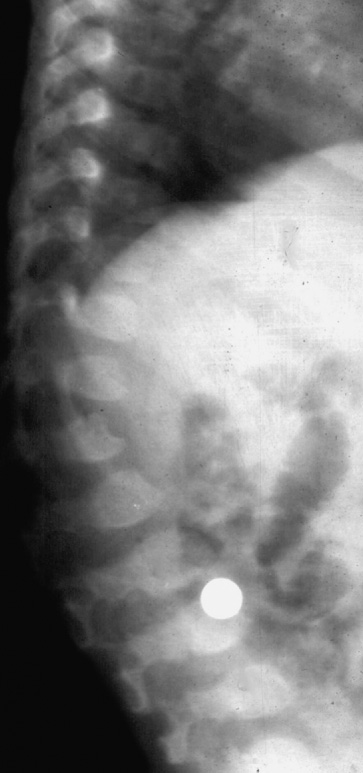
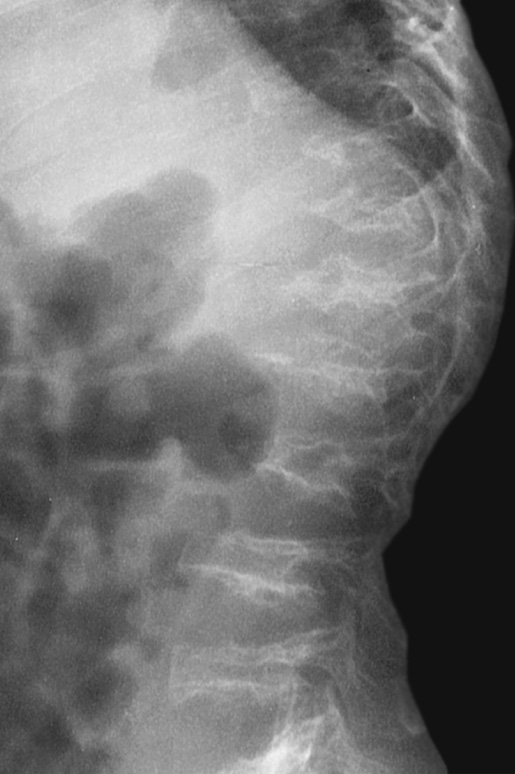
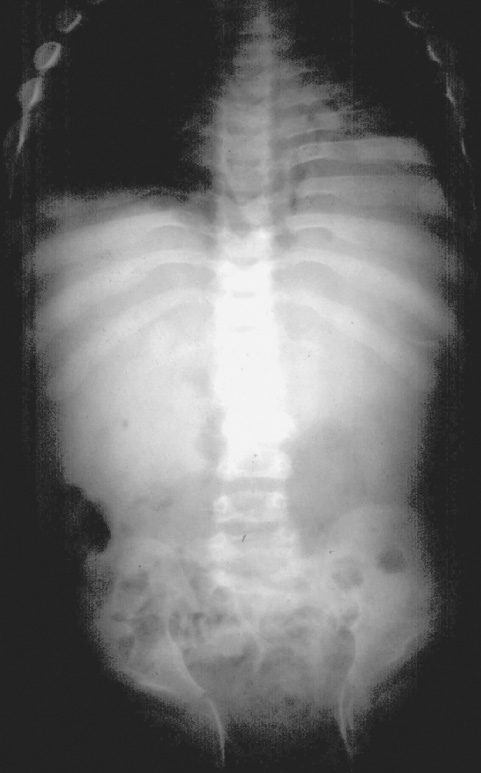

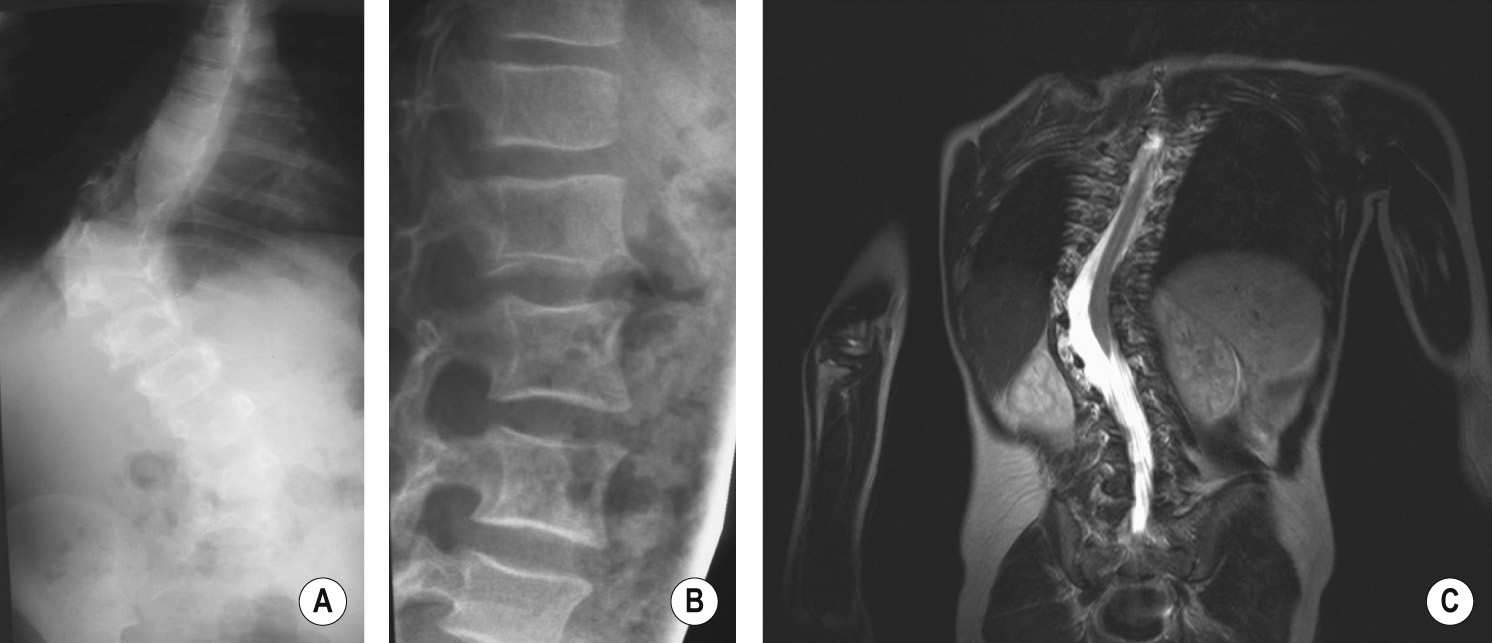
These represent >80% of all spinal arteriovenous malformations ▸ middle aged me leading to gait disturbance, paresthesia and incontinence
Location: located within the spinal dura mater close to a root sleeve ▸ they are commonly found within the thoracic region (although within the cervical spine they are only found around the foramen magnum)
Anatomy: usually supplied by 1–2 radiculomeningeal arterial branches with shunting via a single vein into an intradural vein ▸ symptomatic lesions demonstrate slow and anomalous venous drainage which remains intradural through a greater part of the spinal canal than normal (venous stagnation is an important cause of a clinical myelopathy)
T2WI: ill defined central intramedullary high SI extending over multiple levels (representing venous hypertensive oedema) ± cord expansion ± low SI rim ▸ engorged perimedullary veins seen as flow voids (dorsal > ventral surface)
T1WI + Gad: diffuse enhancement of the cord ▸ enhancing perimedullary veins ▸ this may demonstrate the site of the dural fistula
This is the gold standard investigation, also allowing access for interventional therapy (e.g. embolization)
Embolization of arteries supplying a fistula may be feasible (if they can be shown not to supply the cord)
In contrast to SDAVFs, these are fed by spinal arteries (radiculomedullary/radicullopial) and are more prone to haemorrhage (intramedullary or subarachnoid)
Glomerular AVMs (plexiform or nidus type): the most common, contains a cluster or nidus of abnormal vessels between the feeding artery and draining vein
Fistulous AVMs (intradural AV fistula): direct AV shunts commonly located superficially on the cord
T2WI: serpiginous flow voids (dilated veins) ▸ oedema (venous congestion) as ill defined high SI with cord expansion
T1WI + Gad: enhancement
Rare vascular malformations composed of sinusoidal-type vessels in immediate apposition to each other without normal intervening parenchyma
Extradural/intradural–extramedullary/intramedullary (commonest)
Discrete episodes of neurological deterioration separated by variable time intervals ± recovery ▸ slowly progressive myelopathy ▸ acute neurological deficit with either gradual or rapid decline
T1WI + T2WI: heterogenous lesions displaying typical ‘popcorn’ appearances (blood products of differing ages) ▸ low SI T2WI rim and hypointense ‘blooming’ on GE sequences (haemosiderin deposition)
A rare complication of arteriosclerotic vascular disease (rich anastomotic blood supply) ▸ it may also complicate an aortic dissection or aortic aneurysm surgery
Thoracolumbar > cervical cord (arterial border zones) ▸ located in the central/anterior territories of the anterior spinal artery – resulting in classical sensory pattern loss of pain and temperature sensation with preservation of touch and proprioception
A venous infarction (due to extensive thrombosis of the local pial veins) is rare
T2WI: high SI within the central cord (‘owl's eyes’ or ‘snake's eyes’ appearance) ▸ mild cord swelling
T1WI + Gad: mild enhancement (breakdown of the blood–brain barrier)
DWI: very sensitive in the acute phase
A rare, devastating condition requiring emergency surgical treatment to preserve spinal cord function ▸ a cause is rarely identified
It presents with acute back pain and a progressive flaccid paraplegia developing over hours
A hyperdense epidural mass, which can be broad based, lentiform or biconvex in shape
Variable signal intensities depending upon the haematoma age
Become a Clinical Tree membership for Full access and enjoy Unlimited articles
If you are a member. Log in here